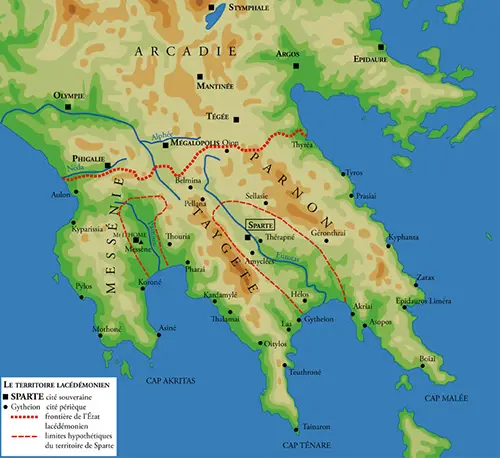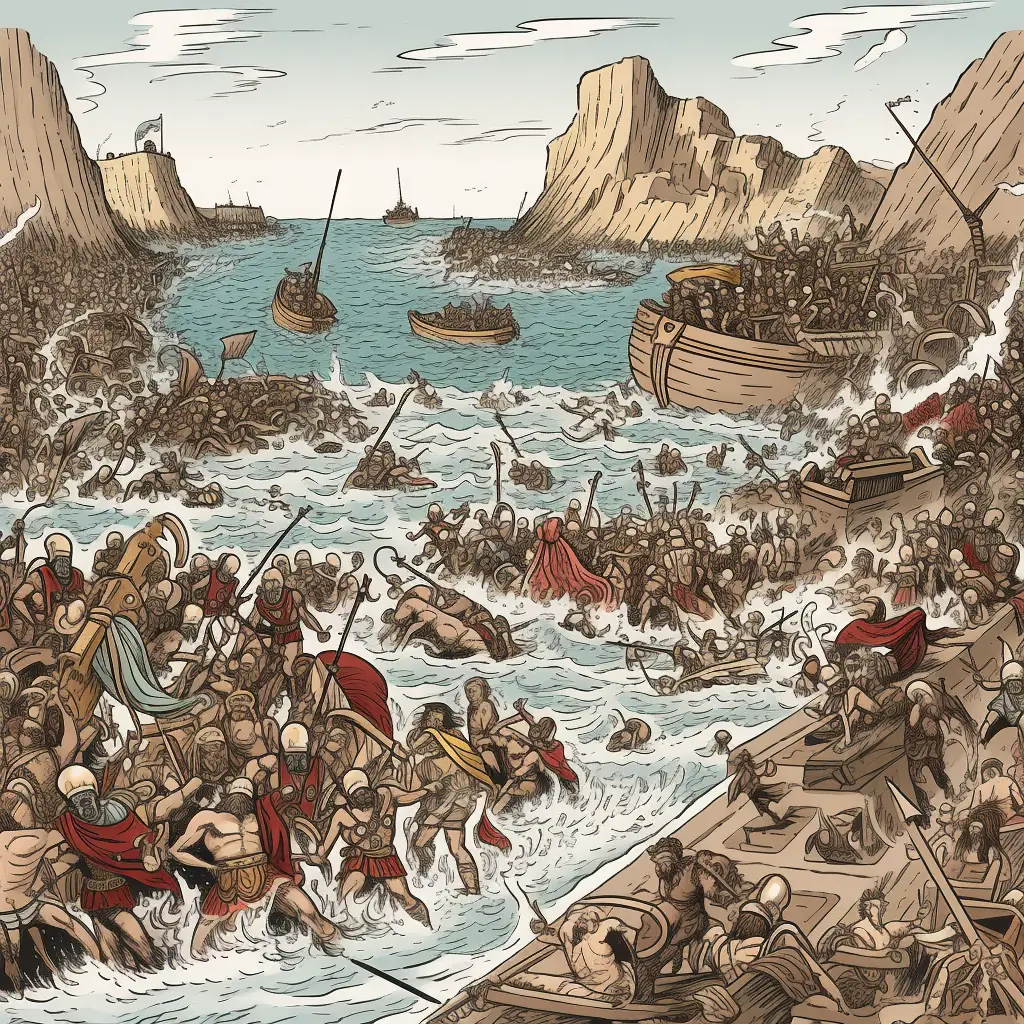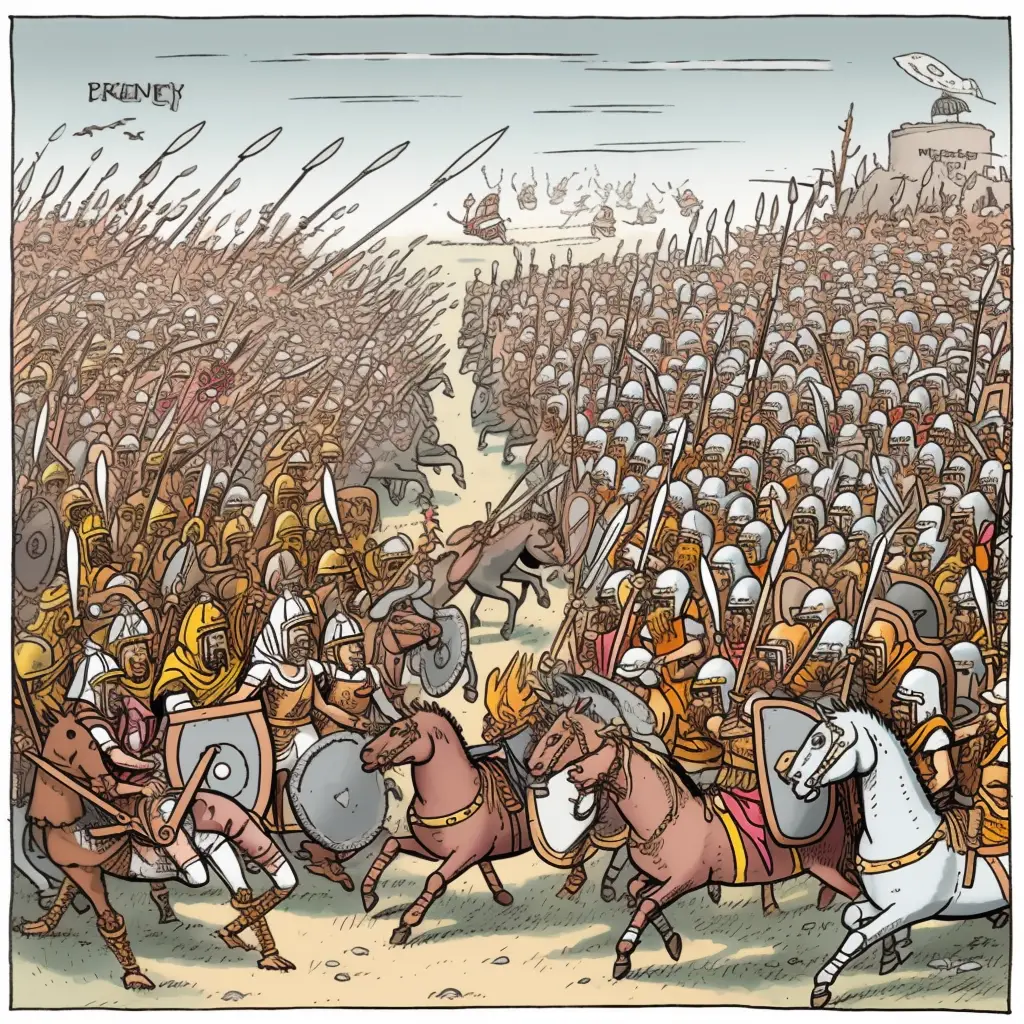Sparta
Sparta was a city-state in ancient Greece known for its military prowess and strict social structure. Boys were trained from a young age to become soldiers, and women were expected to produce strong offspring for the army.
The Spartan army was feared throughout Greece and played a significant role in many battles, including the famous Battle of Thermopylae. Despite its military might, Sparta eventually declined due to a lack of innovation and a rigid society that stifled creativity and progress.
Sparta was an important and powerful city-state in ancient Greece.
It was located in the southeastern portion of Greece along the shoreline of the Eurotas River.
Other regions ruled by Sparta included Laconia and Messenia. Sparta was known as a warrior society and had a dominant army.
Spartans were not educated or forced to study art, theater, or philosophy. Spartans studied the art of war and how best to dominate their opponent on the battlefield.
They had the toughest army of all ancient Greek city-states. Every Spartan man trained to become a soldier from an early age.
Sparta Facts for Kids
- Sparta was an ancient city in Greece.
- It was known for its powerful army.
- Spartan boys began military training at 7.
- Spartan girls received physical education too.
- Spartans ate simple meals like black broth.
- Two kings ruled Sparta at the same time.
- Sparta won against Athens in Peloponnesian War.

History of Sparta
Sparta first rose to prominence about 650 B.C.E.
The Spartan army led all the ancient Greek city-states in the Persian Wars from 492 B.C.E. until 449 B.C.E. when they defeated the Persians.
The most famous battle by Spartan soldiers happened at Thermopylae during the Persian Wars.
Three hundred Spartan soldiers were instrumental in allowing the ancient Greek army to escape while they fought off hundreds of thousands of Persians led by the Persian King Xerxes.
Sparta was not always friendly with other ancient Greek city-states, especially Athens.
For instance, the Spartans fought the Peloponnesian Wars against Athens for 27 years finally defeating Athens in 404 B.C.E.
As Sparta declined they would lose the Battle of Leuctra to Thebes in 371 B.C.E. Sparta continued to be an independent city-state until 146 B.C.E. when ancient Greece as a whole was conquered by the Roman Empire.
Citizens and People of Sparta
There were many types of people that lived in Sparta.
Citizens of Sparta enjoyed more rights such as the right to a fair trial, the right to become a well-trained soldier and live in the city-state-owned barracks.
Becoming a citizen in Sparta was difficult at times.
A person needed to prove they were of original Spartan descent to become a citizen.
This entailed paying someone to research their heritage.
If a person could not pay for research or prove they were a descendant they could not become a Spartan citizen.
Non-citizens in Sparta were called Perioikoi.
These individuals enjoyed numerous freedoms.
They could travel freely to other cities, trade goods, and even own land. Many of the people were of Laconian descent.
The lowest social class of people in Sparta was slaves.
These people were called Helots and generally farmed their own lands.
When harvest time came around they were required to hand over half of their crops to Spartan citizens.
Helots were routinely beaten once a year by Spartan citizens.
They were required to wear clothing made of animal skin and if a Helot was caught while escaping they were killed.
Spartan Army

The Spartan army was central to Sparta’s societal structure and power in ancient Greece. Known for its discipline and efficiency, this army comprised Spartan citizens who underwent intensive military training from childhood.
Their combat skills, bravery, and unique formations like the phalanx earned them a reputation for military excellence. The Spartan army’s significant roles in key conflicts like the Persian Wars and the Peloponnesian War reinforced Sparta’s influence in ancient Greece.
The Spartan army was a fierce bunch of soldiers. When the Spartan army entered battle they formed a Phalanx formation.
Soldiers stood next to each other in several rows of men.
They moved forward as one group with their shields, known as aspis, locked together while stabbing their enemies with a spear called a dory.
Spartan soldiers also carried a small sword named a xiphos.
Their clothing was a crimson-colored tunic which did not allow their enemy to see any type of bleeding from a wound.
A Spartan soldier worshipped their shield and it was seen as a disgrace if a Spartan soldier lost his shield during battle.
Peloponnesian War

The Peloponnesian War was a significant event in Spartan history, where they led the Peloponnesian League against the Athenian-led Delian League. Sparta’s strategy, guided by key figures like King Archidamus II and General Lysander, aimed to weaken Athens by destroying its lands, while avoiding high-risk battles.
Sparta, backed by Persian resources, blockaded Athens, resulting in their victory. However, the prolonged conflict strained Spartan resources, contributing to its future decline
Ancient Greek Warfare
Sparta was pivotal in Ancient Greek warfare due to its militaristic society and exceptional land forces. Spartan society mandated military training for all male citizens from a young age, resulting in the renowned Spartan hoplites.
These well-trained, heavily-armored infantrymen were central to many significant battles in Greek history. However, despite their dominance, Sparta’s military growth faced limitations due to their strict citizenship policies and adherence to traditional warfare strategies. Thus, Sparta’s role in warfare greatly influenced the military strategy and tactics of Ancient Greece.
Helots
The helots, a subjugated population in Sparta, were crucial to the city-state’s socio-economic structure. They were primarily the original inhabitants of regions conquered by the Spartans, living a life similar to serfdom.
The helots’ role was to farm the lands of Spartan citizens, enabling the latter to focus on military and civic activities. However, the disparity in numbers between the helots and the Spartan citizens led to constant tension and fear of rebellion, leading to a complex and often strained relationship.
Therefore, the helots played a critical role in both supporting and challenging Spartan society.
Spartan Society
Spartan society was uniquely designed to support its militaristic lifestyle and maintain power. It was divided into three groups: the Spartiates, who were full citizens and soldiers; the Perioeci, non-citizen free people involved in trade and crafts; and the Helots, who were essentially serfs.
This society operated under a mixed political system and was known for the relatively greater freedoms given to women compared to other parts of ancient Greece.
This combination of military discipline, social hierarchy, and unique societal norms played a crucial role in defining Sparta’s character
Spartan Women

Spartan women had unique roles and freedoms compared to women in other ancient Greek city-states. They were allowed to own property and received education, preparing them for their roles as mothers of warriors.
With men often away for military duties, women held significant responsibilities at home, becoming important figures in society. Their autonomy and roles were crucial in maintaining the Spartan societal structure and supporting its military culture.
Lycurgus of Sparta
Lycurgus of Sparta, despite the debate surrounding his historical existence, is recognized as the architect of Spartan society’s distinctive structure. He is credited with initiating key Spartan institutions, such as the rigorous military education system, the practice of communal dining, and the city-state’s mixed political system.
Whether a true historical figure or a symbol, Lycurgus’ supposed reforms formed the foundation of Spartan society and encapsulated the Spartan ideals of discipline, equality, and military excellence.
Battle of Thermopylae
The Battle of Thermopylae in 480 BC was a notable event in Spartan history, symbolizing Spartan bravery and sacrifice. King Leonidas I of Sparta and his force, including 300 Spartans, held off a much larger Persian army for three days at the pass of Thermopylae.
Even when defeat became inevitable, Leonidas and a contingent stayed behind, ensuring the rest of the Greek forces could retreat. While a tactical defeat, the battle delayed the Persian advance, providing valuable time for Greek defenses. It stands as a testament to Spartan valor and resistance.
Athens
Athens and Sparta, despite their contrasting societies, played crucial roles in ancient Greek history. Sparta was a disciplined, militaristic oligarchy, while Athens was a democracy known for its cultural and intellectual pursuits.
The two city-states united against the Persian Empire in the Persian Wars but later fought against each other in the Peloponnesian War, led by opposing alliances. Sparta’s victory marked its peak but also initiated its decline due to the strains of the war.
Therefore, the relationship between Sparta and Athens significantly influenced the course of ancient Greek history.
Persian Wars

The Persian Wars in the early 5th century BC were significant in Spartan history, highlighting Sparta’s military strength and strategic leadership. Sparta played a key role in resisting Persian invasions, alongside Athens and other Greek city-states.
Notably, King Leonidas I’s stand at the Battle of Thermopylae became a symbol of Spartan bravery. Moreover, under Spartan general Pausanias, the Greeks achieved a critical victory at the Battle of Plataea, effectively ending the Persian threat.
These events underlined Sparta’s military might and its commitment to Greek independence.
Thebes
The relationship between Thebes and Sparta, two ancient Greek city-states, was a mix of alliances and rivalries, influencing the political landscape of the era. Initially, Thebes was a part of Sparta’s Peloponnesian League, but it eventually sought autonomy, leading to conflict.
The Battle of Leuctra in 371 BC, where Thebes emerged victorious, marked a significant shift in power, reducing Spartan influence and elevating Thebes. This interaction between Thebes and Sparta played a key role in shaping the classical Greek era.
Life in Sparta
Life in Sparta was much different for males and females.
Spartan boys were raised by their mothers until the age of seven years old when they would enter a military-type school called an Agoge.
Here they were taught to read and write but mainly trained to fight in the Spartan army.
Spartan boys lived with each other in barracks.
They were beaten daily, given very little food to eat, and they were made to fight each other.
The Agoge was a place that taught Spartan boys how life was during a time of battle.
At the age of 20 years old, the boys entered into the Spartan army.
Girls on the other hand also entered school at seven years of age.
They were also taught how to be strong with exercise and athletic sports.
But their school was not a training ground for women soldiers.
Girls were married off by 18 years of age.
Spartan women enjoyed many more freedoms than other ancient Greek women.
They could own businesses, and land, and could travel outside the house without permission from their husband or father.
During times of war, Spartan women were expected to take care of everything at home including defending their lands against enemies when needed.
More Fun Facts about Sparta
- Sparta was ruled by an oligarchy and two kings.
- There were five men called the Ephors who observed the kings. There was also a council of 30 men who along with the two kings created new laws.
- Each Spartan believed they were a descendant of Hercules, the Greek hero.
- Spartan men had to be fit to fight until the age of 60 years old when they could retire from the Spartan army.
- Young Spartan boys stole food regularly. When and if they were caught stealing they were punished for being caught not for stealing.
- It was not uncommon for Spartans to kill a Helot or a Perioikoi and receive no punishment.
- Sparta was considered a Warrior Society and if a Spartan family had a deformed or ill child at birth, the child was killed.
- Spartans did not create beautiful artwork like other ancient Greek city-states.
FAQ’s
How did Spartans raise their boys?
Boys were raised by their mothers until seven years old. Then they received a military education at the Agoge. Spartan boys were trained at the Agoge to become Spartan soldiers.
What type of rights or freedoms did Spartan girls and women enjoy?
Girls were taught to be fit and have strong families.
They were married by the age of 18 years old. Spartan women could own land and businesses, and they could travel outside their homes without the permission of the oldest Spartan male in the household.
What is Sparta famous for?
Sparta is famous for being a warrior society. The city-state reached its peak of power after it defeated Athens in the Peloponnesian Wars. Their society was based on military service and loyalty to the city-state.
Where was Sparta located in ancient Greece?
Sparta was located along the banks of the Eurotas River in southeastern Greece.
What were the social classes in Sparta?
Spartan citizens had to prove they were from an original Spartan descendant.
Citizens enjoyed more rights. Perioikoi were people generally from Laconia.
They could own land, trade goods, and travel freely between cities.
Helots were slaves that worked the lands in Sparta.
Perioikois and Helots could be killed at any time for no reason by a Spartan citizen.
What did you learn?
-
What enemy did the Spartans fight against at the Battle of Thermopylae?
Persians
-
What was the name of the fighting formation used by the Spartan army?
Phalanx
-
Sparta defeated Athens in which war?
Peloponnesian Wars
-
Where did Spartan boys train to become Spartan soldiers?
Agoge
-
What three types of social classes existed in Sparta?
Spartan citizens, Perioikois, and Helots



